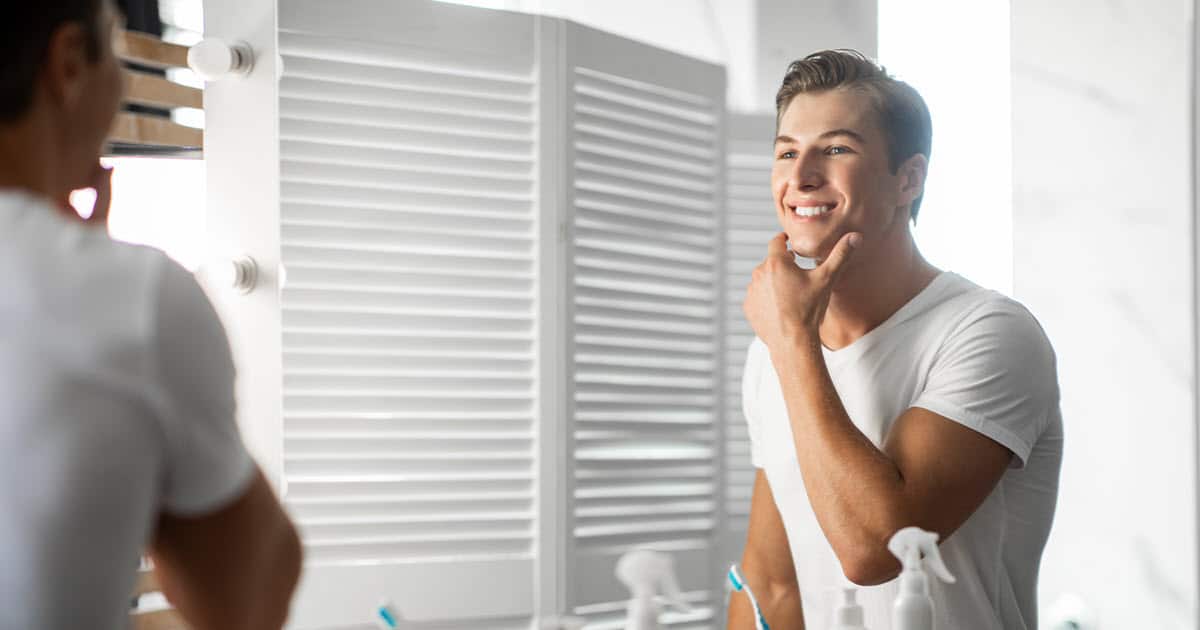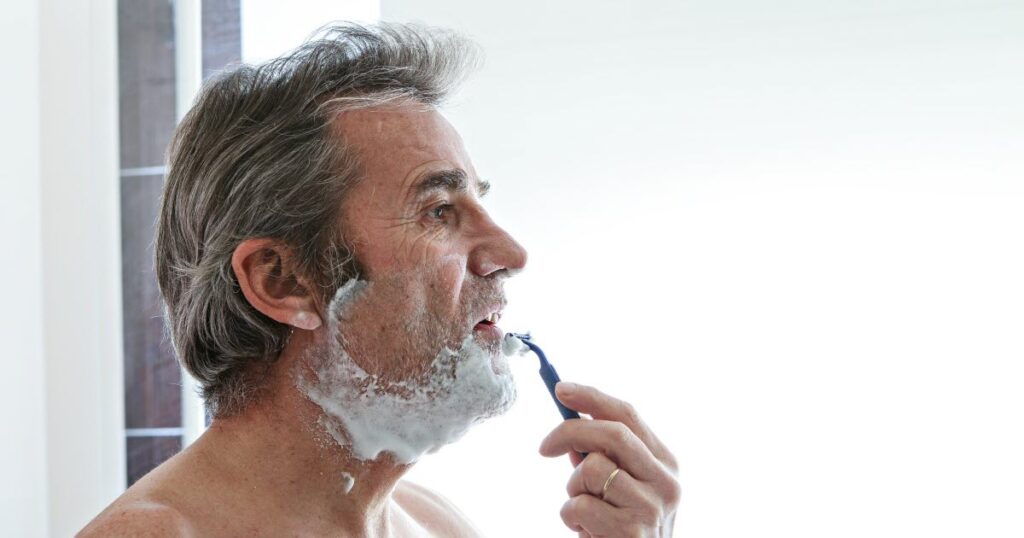Welcome! In this post, we’ll be discussing the post-shave routine that many men incorporate into their daily shave. We’ll talk about the types of products you can use, how to use them, and how to take care of your skin, and how to deal with the most common problem shavers experience: cuts. To wrap up, we’ll provide some usage tips and things to look out for.
As with most posts on our site, the post-shaving routine we’re discussing is for wet shavers—men who use traditional soaps and creams to make a lather, safety razors or straight razors to shave, and various aftershaves and balms—but if you’re not a wet shaver, and you’re using a regular disposable or cartridge razor, the steps below should work for you, too.
First up:
Post-Shave Process: For All Shavers
Regardless of what type of razor you use, or what products you choose to use after you get done shaving, all shavers will want to do the following:
Review Your Work
Even while it may look like you’ve gotten a close shave, you may not be done with your razor yet! You won’t know for sure if you’ve gotten a truly close shave until you take your fingers and lightly trace the contours of your face. Go against the grain, and you’ll feel any areas where whiskers remain. Load your shaving brush with some shaving cream or shaving soap, apply the cream or soap to the area you need to re-shave, and give it a very gentle against-the-grain pass (one quick note: people with sensitive skin may experience skin irritation after multiple passes in the same direction, so keep that in mind—if you have sensitive skin, an against-the-grain pass may not be a good idea).
Warm Water Rinse
Cup your hands, fill them with warm water, and get all the soap, creams, whisker bits, etc. off your skin. You want to make sure all of that is off before you go any further, because those liquids and creams can irritate the heck out of your skin if they stay on you all day. As always, use warm water as opposed to hot water—hot water strips your skin of protective oils, and warm water will get the job done without drying you out.
Cold Water Rinse
This is one of those steps that some guys perform and some guys skip: after making sure you’ve removed all the shaving products from your face with warm water, splash some cold water all over your face. It’ll cause your skin to constrict a little bit, and close your pores a little, and make you a little more alert.
As we mentioned, some guys love that splash of cold water—it can feel great and wake you up—while some others hate the feeling of anything cold after they’ve gotten nice and warm and clean. It’s definitely best practice to give yourself a quick rinse with cold water, but a lot of guys skip that step. Up to you.
Pat Dry
After you’ve gotten everything off your face, your skin will probably be sopping wet. Pat it dry with a towel, and try not to rub it dry. Rubbing your skin can strip it of protective oils, dry it out, and lead to irritation. You want to be especially careful of the skin underneath your eyes, because it’s incredibly sensitive, and prone to damage.
Again, that’s a “best practices”-type thing. Plenty of guys rub their skin dry and nothing happens, but for guys with sensitive skin or guys who are pre-disposed to getting wrinkles, patting the skin dry is a good idea.
Good to Go!
If you’re a “no frills” kind of guy, you’re good to go! There are a lot of other post-shave products you can use, but if you want to keep it simple, doing a warm water rinse, a cold water rinse, and a pat dry can be the end of your shaving routine. If you’re interested in skin protection, skin fortification, or scented treatments, there are plenty of…
Post-Shave Items You May Choose to Use
Here’s the “real” discussion when it comes to post-shave routines: what products to use. Here are some of the more common post-shave products, along with some tips on how to select and use them.
Keep in mind, you don’t need to use each of the items below (and we’ll talk about the order in which you can use two or more of these products in a section below); you can find what works for you, and ditch the rest.
Alum Block: Effective
Alum is a natural mineral substance, and when used for shaving purposes, it’s shaped into square or rectangular blocks. It usually has a grey-ish white tone, and looks a little bit like marble or stone. After a shave, when your skin is still wet, you take the block and rub it over the areas you’ve shaved. The block will do two things:
1) It’s an astringent, so it will make your skin tissues contract. If you’ve got a small cut (aka, a “weeper”) and you trace an alum block over it, it can stop the bleeding very quickly. Obviously, more serious cuts may continue to bleed a little bit, but in our experience, alum block closes up smaller nicks and cuts very effectively; and
2) It’s an antiseptic, so it will kill any lingering bacteria on your face. Definitely a good thing if your shave results in a few nicks.
Actually, it’s got a third use, as well: when used on a cut, it can wake you the heck up. In other words, it hurts! Maybe “hurts” is not the right word for it, but it’s a very sharp, very bright sensation, and it WILL get your attention. It fades very quickly, but—be prepared! Still worth it, though, especially if you’ve got weepers.
After you’ve used the alum block on your face, you can give yourself a good rinse—it’s meant to be removed after use.
As for products, we like the Gentleman Jon Alum Block.
One quick note before we move on to styptic pencils: alum block may not be a good option for guys with dry or sensitive skin, as it might dry you out or irritate you, so proceed with caution. You might want to try witch hazel instead. Witch hazel comes from a flowering shrub, and it’s 1) an astringent (meaning, it helps with small cuts) and 2) an antiseptic (meaning, it kills some errant bacteria on your face). It’s available in liquid form, it doesn’t sting the way that alum block can, and a lot of men use it as an aftershave. Thayer’s Witch Hazel is a popular pick, and it’s alcohol-free, which is a good thing for men with dry/sensitive skin.
Styptic Pencils: Similar to Alum Block, But…
A styptic pencil (sometimes just referred to as a styptic) is for pin-point cut maintenance. It’s usually shaped like a pencil (although it’s sometimes also sold as a gel or a powder), and you apply it to a significant cut on your face. Whereas you’d take an alum block and rub it lightly over all the areas you’ve shaved, a styptic is for use on a particularly bad cut at a specific spot on your face.
We mentioned above that you should rinse off after using an alum block—that’s not the case with styptic pencils. Because a styptic is used on a specific area of the face that has a more aggressive cut, you’ll want to leave it on for a while. You’ll see a little bit of white residue where you used the pencil, but that’s fine—if you wash it off, the wound may start to bleed a bit again.
Remember how we mentioned that alum block can sting? So do styptics. They work really well, though, so again, it’s worth it, especially if you have a cut that won’t stop bleeding.
As for products, we like Clubman. Weird name, great product.
Aftershaves: Types and Uses
Aftershaves have come a long way in the past decade or so. They used to be seen as overbearing or try-hard, but shaving companies have gotten their acts together and made some truly fantastic, truly helpful products over the last couple of years. There are different types of aftershaves, so we’ll present them by type and talk about their pros and cons.
Aftershave Splash
Splashes are the “traditional” aftershave, and they’re basically liquids that have astringents in them (to tighten your skin and minimize pores), toners (to hydrate and/or cleanse your skin), and hydrosols (to add fragrance and aroma to the liquid). They’re a great post-shave product, and they smell fantastic (well, many of them do, anyway).
If you’ve got sensitive/dry skin, you’ll probably want to stay away from splashes—many splashes contain alcohol, and alcohol can dry you out and cause some irritation (in fact, even some of the alcohol-free versions can dry you out and cause irritation). Don’t worry, though—aftershave balms may be a good fit for you, and we’ll talk about those in a minute.
Here’s the good part—if you’ve got oily skin, aftershave splash can be a great choice. It can mitigate some of the excess oils on your skin, and dry you out a little bit.
As for products, Clubman Pinaud makes a good “starter” splash—it’s a great choice if you’re new to splashes and want to see if your skin can handle them—and Barberry Coast’s Bay Rum Aftershave is a fantastic product if you want to treat yourself.
Aftershave Balms
These are relatively new on the market (well, not “new,” but when you consider that the “shaving market” goes back for many millennia, they’re pretty new), and in our opinion, they’re pretty fantastic. They have the consistency of a lotion, and they can provide a lot of benefits: they smell great, they soothe the skin, and they’re usually filled with ingredients that moisturize the skin and promote skin health.
As we mentioned, splashes can cause dry skin, and what’s worse, they can hurt. Shaving companies eventually got the message (“perhaps instead of creating a product that hurts, we can make one that feels good”) and they created balms. The usually contain a conditioner to moisturize the skin (usually a natural oil or butter), humectants (to retain moisture and keep it inside the skin), antioxidants (to keep skin young and healthy-looking), and essential oils (to make them smell appealing). If you’ve got dry or sensitive skin, an aftershave balm may be a great addition to your post shave routine.
We like Lather and Wood Sandalwood Aftershave Balm, but there are a wide range of balms that smell great. The essential oils used in balms range from menthol to oakmoss to patchouli to tea tree to lemon to lime to vanilla and sage. There are dozens of essentials oils used in aftershave balms, and each one has its own unique smell. Finding the ones you like most can be a very satisfying search.
Aftershave Lotions
These are basically aftershave balms, but they feel a little more loose and more liquid-y. They’re meant to absorb into your face quickly, and just like balms, they’ve got a lot of ingredients that moisturize and protect the skin.
Cologne: Just for Smelling Good
Cologne is like that friend of yours who’s not really good for much, but he’s a lot of fun to have around. Whereas all of the other products in our post-shave list perform some kind of function—to tighten the skin, moisturize it, or soothe it—cologne is just there to smell good. That’s it! No more, no less.
Cologne usually has a high alcohol content, so if you’ve got sensitive and/or dry skin, you may want to stay away, but it’s always used in very small doses, so you can experiment and see if your skin can handle it. As for everyone else, a little cologne goes a long way, so you needn’t overdo it. The scent you get with a cologne is usually stronger than the scents related to aftershaves and balms. That said, it usually evaporates quickly—something to keep in mind if you want to maintain the fragrance but you’re going to be out for a while.
We’ve written an entire post about the colognes we like, and you can check that out here.
Talcum Powder: Not Just for Barbers
The last item in our post-shave discussion is a little less common, but there are plenty of shavers who love it: talcum powder. As the last step in your shaving routine (after you’ve make sure your face is dry), you can apply the talc with your hands or with a brush or neck duster (like the Marvy Horsehair Neck Duster). The talc will soak up some of the excess moisture (so it’s good for guys who sweat a lot, or have oily skin), and it’ll reduce a little bit of the chafing if you wear a suit and tie and your collar rubs on your neck all day.
As with most items related to shaving, it’s hard to go wrong with Taylor of Old Bond Street. Taylor of Old Bond Street Sandalwood Talcum Powder has worked wonders for us.
Order of Application
So! Those are the most common post-shaving items. Here, we’ll discuss how you should use them, and in what order shavers tend to use them.
There’s no “set-in-stone” post-shave process, but here’s what would probably be the most common post-shave routine:
Warm water rinse to remove any lather and/or whiskers that have stayed on the face;
Cold water rinse to close pores and tighten skin;
Alum block rub over shaved areas of the face OR apply which hazel;
Cold water rinse to get remove the residue of the alum block (or the witch hazel);
Pat skin to dry; and finally
Apply aftershave splash or balm or lotion.
That sounds like a lot of steps for something so simple—you’re rinsing off a number of different times—but it actually takes very little time. For most guys, the whole post-shave routine takes a minute or two at most, and then you’re good to go!
Some Pro Tips
Before we wrap up, there are some pointers you’ll want to keep in mind:
Remove What Needs to Be Removed. Most of the products above don’t need to be removed after you use them. That’s true for aftershave splash, aftershave balm, talc, and cologne. Alum block, however, DOES need to be removed, so if you choose to use it, be sure to give your face a rinse and get it off. You may find your skin to be very irritated if you leave that on too long.
Clean the Sink. Shaving tends to make a mess, and if you’ve got one of those older sinks that feature all sorts of weird angles where water pools, chances are strong that if you don’t clean up—dry up any excess water on the sink counter top, wipe up any stray shaving cream, wash away any loose whiskers—you’re leaving a mess for whoever comes next. If you live alone (you lucky dog), you can skip this step, but—still! Never hurts to be tidy.
Don’t Get Confused. There are a lot of post-shave products out there, and some of them—aftershave balms and moisturizing lotions in particular—are very similar, if not the same thing. For products that overlap a little bit, hang in there—the more you use them, the more sense they’ll make, and the more you’ll be able to tell what irritates your skin and what replenishes you and makes you feel good.
No More Tissues on Your Face! Seriously—if you get nicks on your face when you shave, check out alum blocks and maybe styptic pencils. They sting a little bit, but it’s not that bad (and some of us actually like that sting, believe it or not! Bam! Wakes you right up!). Using tissues on your face to clot small cuts… it’s just not a great look, especially when you forget to take them off, and you’re walking around the office with tissues all over your face. It’s just our opinion, but that’s something you should avoid if possible.
Don’t Get Overwhelmed. For real—there are so many wet shaving products, it’s crazy. Every step of the shaving process has different products, made by different companies, with different features you can use. It can be really overwhelming at first. If you want to keep it simple, start with the “big name” companies and branch out. Truefitt & Hill, Taylor of Old Bond Street, and Geo. F. Trumper have been around for more than a century, so they must be doing something right. Take a look at their products offerings and see what stands out to you.
If You Hate the Sting, Stay Away from the Splash. Some of us have a tendency to commit to doing uncomfortable things, just because that’s how it’s “supposed” to be done. Don’t. Life’s too short for that. If you want to like an aftershave splash but don’t, don’t use it. Find something you like and go with that. Balms are a great alternative, and a lot of them are truly soothing. Again, find what you like, and don’t settle for anything less!
Off You Go, You Rogue
Alright, that’s it for our after-your-shave post! Enjoy your next shave!
Michael Morris is the head writer here at Rough and Tumble Gentleman. He's got a ducktail beard and loves Brazilian jiu-jitsu. He's married to the woman of his dreams and lives in Brooklyn, NY.




